Overview
The ADI-R questionnaire PDF is a valuable tool for parents seeking effective autism assessment. It offers a structured approach to gather detailed information about an individual's communication, social interaction, and repetitive behaviors—key elements in diagnosing autism spectrum disorders. This approach not only ensures thorough evaluations but also fosters tailored intervention strategies that can make a significant difference in a child’s development.
What makes the ADI-R particularly effective is its reliability, as highlighted in the article. However, it’s essential to have qualified administrators who understand the nuances of each assessment component. This understanding is crucial for ensuring accurate evaluations that truly reflect the individual needs of each child.
As you navigate this journey, remember that seeking support and resources can be incredibly beneficial. Consider reaching out to professionals who can guide you through the process. Sharing your experiences with others can also provide comfort and insight. Together, we can foster a nurturing environment for our children and help them thrive.
Introduction
In the realm of autism assessment, the Autism Diagnostic Interview-Revised (ADI-R) serves as a crucial tool, thoughtfully crafted to gather vital information about an individual's developmental history and behavioral patterns. As the prevalence of autism spectrum disorders (ASD) continues to rise, it becomes increasingly essential for both clinicians and families to grasp the nuances of the ADI-R. This comprehensive questionnaire not only addresses key areas such as communication, social interaction, and repetitive behaviors but also highlights the importance of collaboration among professionals to ensure accurate diagnoses.
By exploring the structure and application of the ADI-R, this article seeks to shed light on its significance in the diagnostic process. It will also discuss the challenges faced and the resources available to enhance its effectiveness in identifying and supporting individuals with autism.
Understanding the ADI-R Questionnaire: An Overview
The Autism Diagnostic Interview-Revised (ADI-R) is a structured interview instrument that plays a vital role in evaluating autism spectrum disorders (ASD). This tool is designed to gather detailed information about an individual's developmental history and current behaviors, making it a cornerstone in the diagnostic process. The ADI-R is particularly valued for its reliability and validity, supported by extensive research in clinical settings.
This evaluation tool focuses on three fundamental areas:
- Communication
- Social interaction
- Restricted or repetitive behaviors
Understanding these components is essential for grasping the multifaceted nature of autism, and they are critical for both parents and professionals involved in the assessment process. Research indicates that language delays and regression are more common among individuals with ASD compared to their typically developing peers.
Statistics reveal that 3.6% of ASD participants experienced a loss of skills, while none of the non-ASD participants did. This underscores the importance of thorough evaluation in these areas.
Typically, skilled professionals administer the assessment tool through interviews with caregivers who are knowledgeable about the person's early development and current behaviors. This collaborative approach not only enhances the accuracy of the information collected but also fosters a nurturing atmosphere for families facing the challenges of developmental evaluations. Recent research emphasizes the necessity of utilizing multiple diagnostic tools to improve the accuracy of ASD identification, as cultural differences can significantly influence symptom reporting.
In practice, the effectiveness of the ADI-R has been substantiated through various case studies, highlighting its role in accurately diagnosing the condition. Clinicians widely recognize this tool as a crucial part of the evaluation process, often relying on it to guide their diagnostic decisions. As Fred R. Volkmar, Director of the Child Study Center at Yale University, notes, the assessment tool is essential for understanding the nuances of diagnosis related to the spectrum.
However, it’s important to acknowledge the limitations in ASD diagnostic studies, as noted in the case study titled "Limitations in ASD Diagnostic Studies." This calls for further research to confirm differences in diagnostic outcomes across various developmental groups. Overall, the ADI-R remains an invaluable resource for healthcare professionals and families alike, promoting a deeper understanding of the condition and guiding effective intervention strategies. If you have experiences to share or questions about the evaluation process, we encourage you to engage with us in the comments or through our newsletters.
Components of the ADI-R: Key Areas of Focus
The ADI-R questionnaire PDF serves as a vital tool in evaluating autism spectrum disorder, encompassing several key elements that delve into various aspects of behavior and development. These components include:
- Language and Communication: This section assesses the individual's ability to use language, covering aspects such as speech development and conversational engagement. It's important to note that children with autism often encounter significant challenges in language skills; research indicates that roughly 25% of children with autism remain nonverbal. Ana Miranda emphasizes, "a comprehensive language evaluation might be a crucial objective of ASD diagnostic practice for enhancing the development of children with ASD-ID." This highlights the critical need for thorough language assessments during the diagnostic process.
- Social Interaction: This area examines how individuals engage with others, focusing on behaviors like eye contact, sharing interests, and responding to social cues. Many individuals on the spectrum experience difficulties in social interaction, making it challenging to form and maintain relationships. Recognizing these difficulties is essential for creating interventions that promote social skills development. With autism affecting an estimated 1 in 54 children in the U.S., the importance of effective assessment tools like the ADI-R cannot be overstated.
- Repetitive Behaviors and Interests: This component looks into the presence of restricted or repetitive behaviors, such as hand-flapping, insistence on sameness, or intense interests in specific topics. These behaviors are characteristic of autism and can significantly impact daily functioning and quality of life. Early intervention can help address these behaviors, reducing associated health risks. Alarmingly, over 50% of children with autism are overweight or at risk for obesity, underscoring the importance of recognizing these risks through assessment tools.
Each of these components is crucial for developing a comprehensive understanding of an individual's behavior and developmental history, which is vital for accurate diagnosis and effective intervention strategies. By utilizing the ADI-R, practitioners can better identify the unique needs of individuals on the spectrum, ultimately leading to improved outcomes and support. Furthermore, the Autism CARES Act of 2014 aims to expand research and enhance collaboration among NIH elements funding ASD studies, further underscoring the significance of assessment tools in the current landscape of autism evaluation.
Accessing and Utilizing the ADI-R Questionnaire PDF
Accessing the questionnaire is a vital step in performing effective evaluations for individuals on the spectrum. You can download the PDF from reputable sources, including clinical assessment websites and autism resource centers. Once you have the questionnaire, it’s essential to familiarize yourself with its format and structure.
Here’s a detailed guide on how to effectively utilize the ADI-R PDF:
- Download the ADI-R questionnaire PDF: Make sure to obtain the most recent version from a trusted source to guarantee accuracy and relevance.
- Review the Instructions: Before administering the questionnaire, take the time to thoroughly read the instructions. Understanding the process and requirements is crucial for a smooth evaluation.
- Prepare for the Interview: Gather relevant information regarding the individual's developmental history and current behaviors. This background will help you conduct a more effective interview.
- Conduct the interview: Use the ADI-R questionnaire PDF to guide the discussion, ensuring that all questions are asked and responses are recorded accurately. This structured approach is essential for gathering comprehensive information.
Recent research emphasizes the efficacy of the tool in medical environments, with notable concordance between remote evaluations and face-to-face reviews. For instance, research conducted by Juárez et al. (2018) demonstrated an 80% agreement rate in evaluations conducted via telehealth, underscoring the reliability of the ADI-R questionnaire in various formats.
Furthermore, it is noteworthy that 100% of the children in the ASD group were born in the United States, providing important context for the population being assessed. As Jeremy Lefort-Besnard stated, "Careful description of these neural differences related to the spectrum disorder will provide important insights into how to make progress toward precision medicine in psychiatry." This highlights the significance of comprehending these differences during evaluations. By adhering to these steps, you can efficiently collect the essential information for a comprehensive evaluation of autism, ultimately aiding in improved outcomes for individuals with autism.
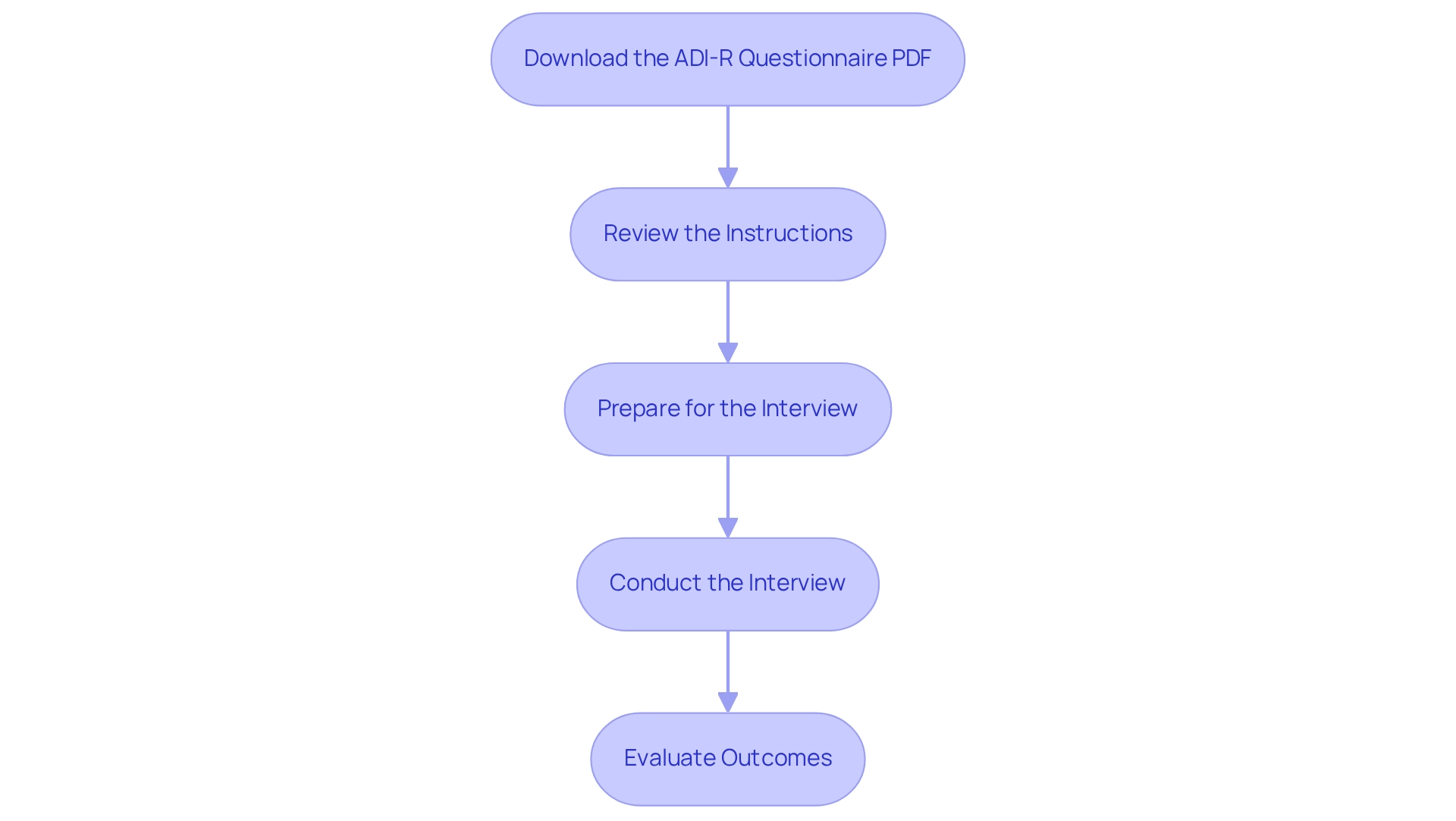
Administering the ADI-R: A Step-by-Step Guide
Conducting the Autism Diagnostic Interview-Revised is a vital process that requires careful attention to detail to ensure a thorough and accurate evaluation. Here’s a step-by-step guide to help you navigate this important assessment.
- Select a Qualified Administrator: Choosing someone who is not only trained but also has significant experience in evaluating autism is essential. Research shows that the qualifications of professionals administering the ADI-R greatly influence the reliability of the results. As highlighted by S. Vanegas, supported by Illinois LEND, having qualified administrators is crucial for effective assessments.
- Schedule the Interview: It's important to find a convenient time for the interview with the caregiver, ensuring that the environment is free from distractions. A calm setting encourages open communication and accurate responses, which are vital for the assessment.
- Gather Background Information: Before the interview, collect relevant documents such as prior evaluations, medical records, and any other pertinent information. This background data is crucial for understanding the caregiver's responses and enhancing the assessment's validity.
- Conduct the Interview: Follow the assessment protocol closely. Ask each question clearly and encourage the caregiver to elaborate on their answers. This approach enriches the data collected and helps in grasping the nuances of the child's behavior.
- Record Responses Accurately: Documenting the caregiver's responses with precision is vital. Capturing all relevant information is essential for subsequent analysis and scoring.
- Evaluate and Rate the Responses: After the interview, thoroughly assess the recorded responses and rate them according to the relevant guidelines. This evaluation process is crucial for identifying autism-related behaviors and determining the appropriate diagnosis.
By following these steps, administrators can effectively carry out this evaluation tool, leading to more accurate results. Importantly, research shows that this tool is widely used, with thousands of evaluations conducted each year, underscoring its significance in the diagnostic process. For instance, a study evaluating the Autism Diagnostic Interview-Revised in a U.S.-based Latino population found that children with ASD scored higher on this assessment than those with other developmental disabilities.
This underscores the potential impact of language differences between parents and children on the validity of communication domain scores. It highlights the necessity for culturally and linguistically appropriate assessment tools to ensure that communication domain scores are both valid and reliable.
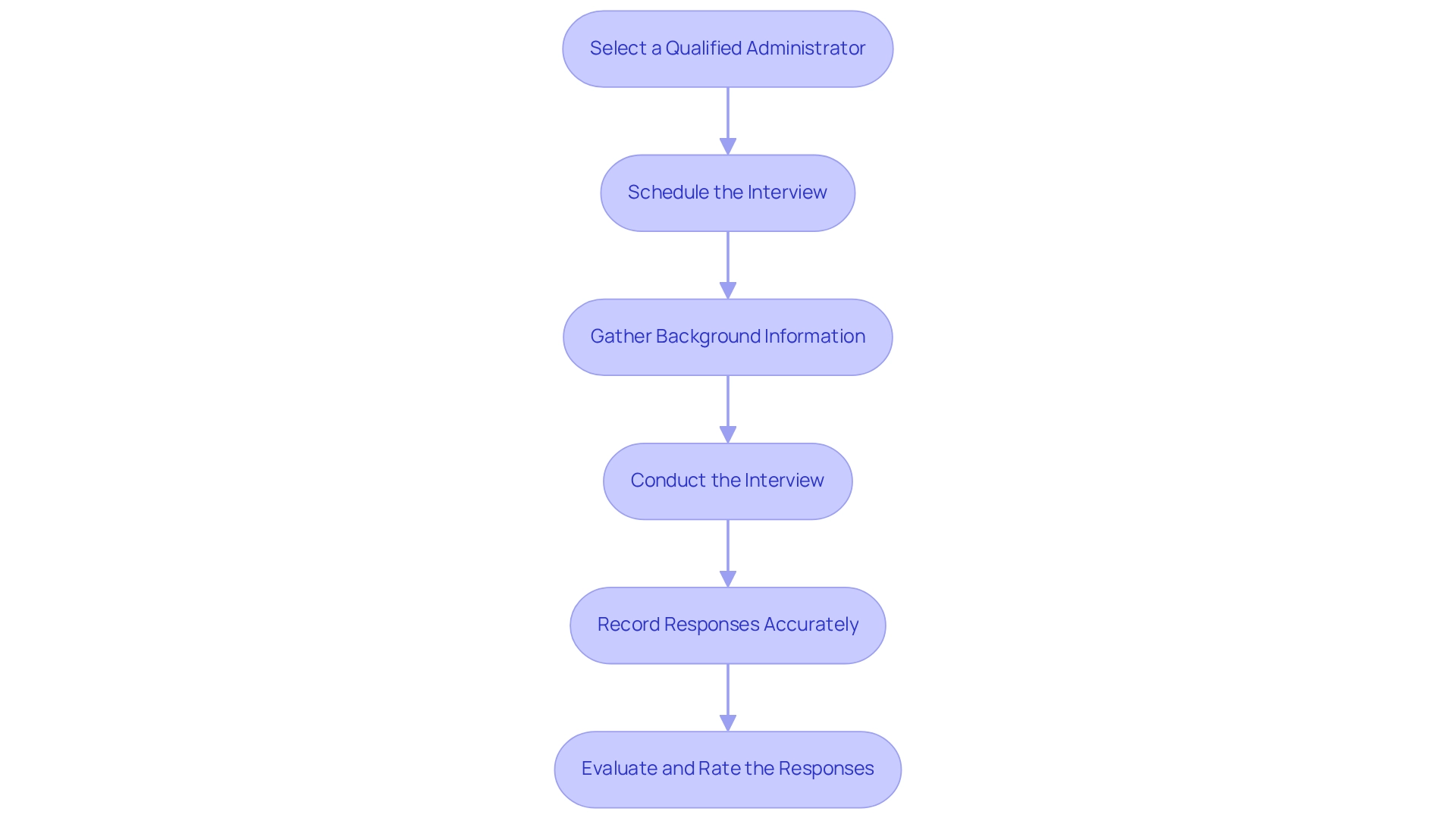
Interpreting ADI-R Results: What the Scores Mean
Understanding the outcomes of the Autism Diagnostic Interview-Revised (ADI-R) requires a compassionate grasp of its scoring framework and how these scores impact individual behavior. The ADI-R uses a coding system where responses are rated from 0 to 3, with higher scores indicating greater concerns regarding autism-related behaviors. Let’s explore how to interpret these scores in a way that resonates with your experiences:
-
Score Ranges:
- 0-1: Indicates typical development with no significant concerns.
- 2: Suggests mild concerns, prompting further observation to see if additional evaluation is needed.
- 3: Reflects significant concerns, strongly recommending further assessment for developmental disorders.
-
Domain Scores:
Each of the three core areas assessed—communication, social interaction, and repetitive behaviors—receives individual scores. Understanding these domain scores is crucial for determining the overall diagnosis and effectively tailoring intervention strategies. -
Thresholds for Diagnosis:
To meet the diagnostic criteria for autism, individuals generally need to score above a specific threshold across all three domains. Current research shows that sensitivity in distinguishing between autism (AUT) and autism spectrum disorder (ASD) cases varies, with studies indicating that specificities for the National Institute of Mental Health (NIMH) sample ranged from 86% to 89% using established research cutoffs. Differences in sensitivity between AUT and ASD cases have been noted across various studies, highlighting the diagnostic nuances that professionals must consider.
Understanding these thresholds is vital for accurate diagnosis and subsequent intervention planning.
The use of ADI-R algorithms has been particularly enlightening across diverse populations, as illustrated in a study titled 'Autism Diagnostic Interview-Revised Algorithms for Toddlers and Young Preschoolers,' which included a non-US sample of 1,104 children. This research underscores the importance of these scores in enhancing early intervention strategies. As professionals continue refining their understanding of ADI-R results, the implications for diagnosis and treatment become increasingly significant.
As noted by Kim and Lord, "This work was supported by the ESF COST Action BM1004 Enhancing the Scientific Study of Early Autism (ESSAY)." This highlights the collaborative efforts to enhance autism evaluation methodologies. Additionally, the report concludes with a summary from the multi-disciplinary team, providing a diagnostic conclusion based on the evaluation results. This enables individuals to decide whom to share the report with, fostering a cooperative approach to analyzing these evaluations effectively.
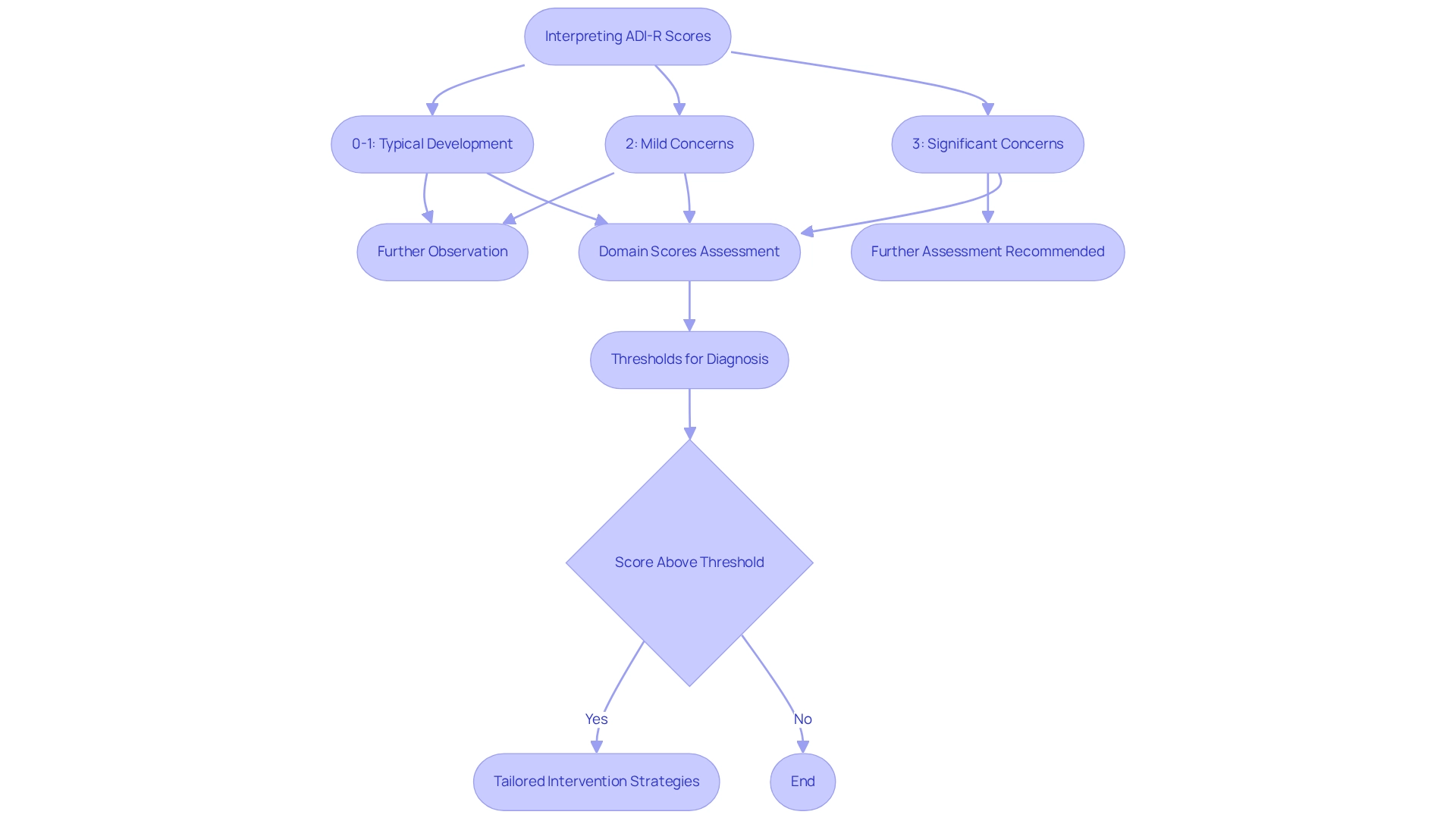
Collaborating with Professionals: Enhancing Assessment Accuracy
Cooperation with experts is essential in the evaluation process, significantly enhancing both precision and dependability. To ensure effective collaboration, consider these key points:
- Involving trained clinicians is vital. Engaging professionals specifically trained in administering the ADI R questionnaire PDF and interpreting its results ensures that the evaluation is conducted with the necessary rigor and understanding of autism spectrum disorders (ASD).
- Sharing detailed information is crucial. Providing clinicians with all relevant background details—such as prior evaluations, medical history, and behavioral observations—helps them develop a comprehensive understanding of the individual being assessed, leading to more informed conclusions.
- Engaging in meaningful discussions is important. After the evaluation, having in-depth conversations with professionals allows families to review the findings together. This dialogue helps families grasp the implications of the results for diagnosis and intervention, fostering a shared understanding of the next steps. As one parent noted, "minimized," emphasizing the importance of clear communication and collaboration.
- Planning for follow-up assessments is beneficial. Scheduling these assessments with trained professionals helps monitor progress and adjust intervention strategies as needed. Ongoing cooperation ensures that the support provided adapts to the individual's needs.
- The significance of teamwork is underscored by the fact that the prevalence rate of individuals diagnosed with ASD is currently 1 in 59. This statistic highlights the growing need for effective partnerships between families and professionals. Moreover, case studies suggest that establishing standards for collaborative practice among professionals treating individuals with ASD can enhance teamwork and improve client outcomes.
- These standards focus on communication, role delineation, organizational support, and client-centered care, emphasizing the need for professionals to demonstrate flexibility and collective ownership of client care.
- It is also essential to recognize that cooperation among healthcare experts and educational institutions can vary. Parents often observe that educators frequently lack the necessary knowledge of developmental disorders to implement suggested strategies effectively. By fostering a collaborative atmosphere, families and experts can unite to ensure accurate evaluations and effective support for individuals with autism, utilizing the ADI R questionnaire PDF.
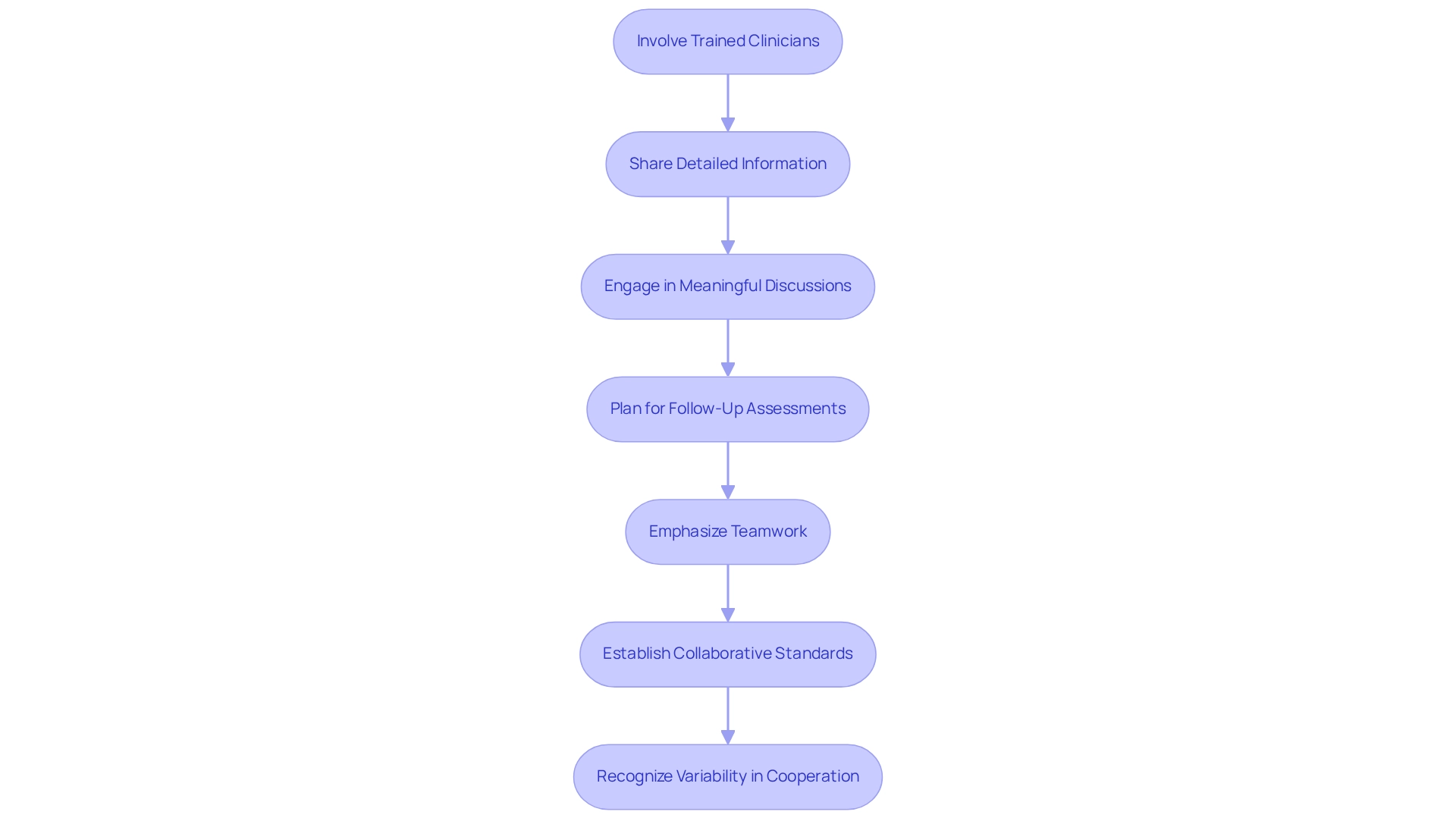
Overcoming Challenges in Using the ADI-R Questionnaire
Navigating the complexities of the ADI-R questionnaire can sometimes feel overwhelming for caregivers, and it's important to acknowledge the challenges that may arise during the evaluation process. Here, we explore some common difficulties along with supportive strategies to help you through them:
- Recall Bias: Many caregivers struggle to remember specific details about their child's early development, which can lead to incomplete or inaccurate responses. To ease this burden, encourage caregivers to review any available records or notes prior to the interview. This preparation can significantly enhance the accuracy of the information provided. Notably, the specificity of the ADI-R in a sample from the National Institute of Mental Health (NIMH) ranged from 86 to 89%, underscoring the crucial role of precise recall in the evaluation process.
- Anxiety During the Interview: It's natural for caregivers to feel anxious during evaluations, which may affect their responses. Creating a supportive atmosphere and offering clear explanations about the evaluation process can help alleviate these worries. Clinicians have observed that fostering a calm environment is essential for obtaining reliable information, as caregiver anxiety can skew results. In fact, a study revealed that 42.9% of children altered their ADI-R diagnostic classification between evaluations, highlighting the fluid nature of the evaluation process and the need for accurate caregiver input.
- Cultural Differences: Cultural perceptions of autism can shape how caregivers respond to questions. It’s vital for interviewers to approach this with cultural sensitivity and to clarify questions to ensure accurate understanding. This not only honors the caregiver's background but also enhances the validity of the assessment. As noted in a case study titled "Broader ASD Criteria and Performance," the inclusion of broader ASD criteria improved identification rates, suggesting that cultural awareness can lead to better outcomes.
- Time Constraints: Conducting assessments can be time-consuming, which might result in rushed interviews and incomplete data collection. To mitigate this, it’s beneficial to schedule ample time for the interview and ensure that caregivers feel prepared. Discussing the structure of the interview and what to expect can help reduce stress and improve the quality of responses. The psychometric properties of the ADI-R questionnaire, as examined by Kelly Y. C. Lai, demonstrate high reliability and validity across different populations, reinforcing the importance of thorough and thoughtful administration of the ADI-R questionnaire.
By addressing these challenges proactively, we can foster a more efficient and supportive evaluation process, ultimately benefiting both caregivers and experts involved in the review of developmental disorders. We encourage you to share your thoughts and experiences, as your insights can help create a more understanding community.
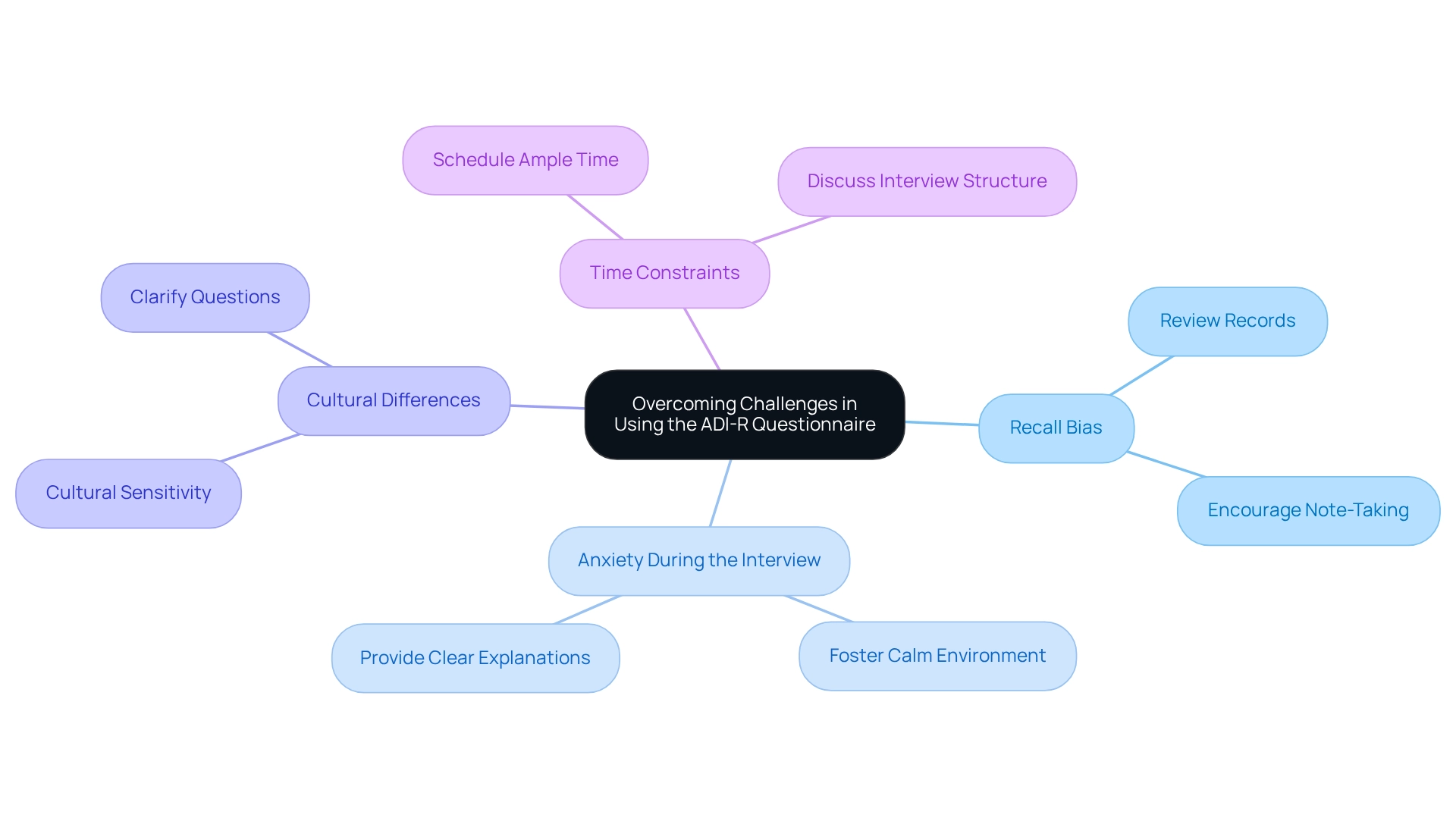
Additional Resources for Effective Autism Assessment
To enhance the effectiveness of autism assessments, it is essential to leverage a variety of additional resources that can provide support and understanding:
- Professional Organizations: These organizations play a pivotal role in offering comprehensive information and resources tailored for families and professionals. They are crucial in promoting a deeper understanding of autism spectrum disorder (ASD) and its evaluation, helping to bridge gaps in knowledge.
- Training Workshops: Participating in workshops that focus on the ADI R questionnaire PDF and other evaluation tools can significantly enhance both comprehension and practical skills. With many local and online training options available, participants can improve their administration skills and boost their evaluation abilities. As highlighted by GK, a consultant, "The studies involving human participants were reviewed and approved by Duquesne University IRB," underscoring the importance of rigorous training and assessment practices that ensure quality care.
- Support Groups: Joining support groups specifically for parents of children with developmental disorders offers invaluable emotional support and practical advice. These groups create a nurturing community where individuals can share experiences and strategies, fostering resilience and empowerment among parents navigating similar challenges.
- Online Resources: Websites like Autism Speaks and the Centers for Disease Control and Prevention (CDC) provide comprehensive details on developmental disorder diagnosis, evaluation tools, and intervention strategies. These platforms serve as essential tools for both parents and professionals seeking to stay updated on the latest advancements in developmental evaluations.
By employing these resources, parents and professionals can greatly improve their comprehension and efficiency in performing autism evaluations, ultimately resulting in better outcomes for those with ASD. With the prevalence rate of individuals diagnosed with ASD currently at 1 in 59, the importance of effective therapies and comprehensive support systems becomes increasingly critical, highlighting the need for well-informed assessment practices. Furthermore, implementing standards for collaborative practice can enhance treatment teams' efforts, improve client care, and ensure that all professionals contribute their unique expertise to the treatment process.
Conclusion
The Autism Diagnostic Interview-Revised (ADI-R) serves as a crucial assessment tool for autism spectrum disorders, focusing on communication, social interaction, and repetitive behaviors. Its structured format, backed by extensive research, ensures reliability and validity in the diagnostic process, making it an invaluable resource for families and professionals alike.
Collaboration with trained professionals is essential in maximizing the ADI-R's effectiveness. Experienced clinicians not only administer the interview but also interpret results with care. Sharing comprehensive background information with caregivers further enhances the accuracy of the data, fostering a supportive environment for all involved.
While challenges such as recall bias and cultural differences may arise during assessments, proactive strategies can help mitigate these issues. Encouraging caregiver preparation and creating a nurturing atmosphere can significantly improve the assessment experience. Additionally, accessing resources like professional organizations and training workshops can deepen understanding and practical application of the ADI-R.
In conclusion, the ADI-R plays a vital role in improving diagnostic outcomes for individuals with autism. By prioritizing collaboration among professionals and families, and addressing the challenges of assessment, we can commit to effective evaluation practices. This commitment ensures that every individual receives the appropriate support and intervention they deserve. As the prevalence of autism continues to rise, informed assessments are essential for promoting brighter futures for those affected. Let’s work together to create a more supportive world for individuals with autism and their families.
Frequently Asked Questions
What is the Autism Diagnostic Interview-Revised (ADI-R)?
The ADI-R is a structured interview tool used to evaluate autism spectrum disorders (ASD) by gathering detailed information about an individual’s developmental history and current behaviors.
What are the main areas of focus in the ADI-R evaluation?
The ADI-R focuses on three fundamental areas: communication, social interaction, and restricted or repetitive behaviors.
Why is the ADI-R considered reliable and valid?
The ADI-R is valued for its reliability and validity, which is supported by extensive research conducted in clinical settings.
How is the ADI-R administered?
Skilled professionals typically administer the ADI-R through interviews with caregivers who are knowledgeable about the individual's early development and current behaviors.
What is the significance of language assessment in the ADI-R?
Language assessment is crucial because many individuals with autism experience significant challenges in language skills, with around 25% remaining nonverbal.
How does the ADI-R address social interaction difficulties?
The ADI-R examines how individuals engage with others, focusing on behaviors like eye contact and responding to social cues, which are often challenging for those on the spectrum.
What types of behaviors does the ADI-R evaluate regarding repetitive interests?
The ADI-R looks into the presence of restricted or repetitive behaviors, such as hand-flapping or insistence on sameness, which are characteristic of autism.
Why is the ADI-R important for intervention strategies?
By utilizing the ADI-R, practitioners can identify the unique needs of individuals on the spectrum, leading to improved outcomes and support through effective intervention strategies.
What role does the Autism CARES Act of 2014 play in autism evaluation?
The Autism CARES Act aims to expand research and enhance collaboration among NIH elements funding ASD studies, highlighting the importance of assessment tools like the ADI-R in autism evaluation.
Are there any limitations noted in ASD diagnostic studies?
Yes, there are limitations in ASD diagnostic studies, which call for further research to confirm differences in diagnostic outcomes across various developmental groups.




